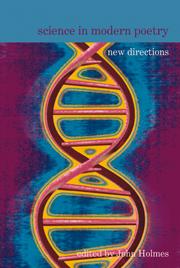Book contents
- Frontmatter
- Contents
- List of Contributors
- Acknowledgements
- Introduction
- Part I Science and Contemporary Poetry: Cross-Cultural Soundings
- Part II Science in Modernist Poetry: Appropriations and Interrogations
- 5 ‘Strange Synthetic Perfumes’: Investigating Scientific Diction in Twentieth-Century Poetry
- 6 The Human Animal: Biological Tropes in Interwar Poetry
- 7 William Empson, Ants and Aliens
- 8 Ezra Pound and the Materiality of the Fourth Dimension
- Part III Darwinian Dialogues: Four Modern Poets
- Afterword
- Bibliography
- Index
7 - William Empson, Ants and Aliens
from Part II - Science in Modernist Poetry: Appropriations and Interrogations
- Frontmatter
- Contents
- List of Contributors
- Acknowledgements
- Introduction
- Part I Science and Contemporary Poetry: Cross-Cultural Soundings
- Part II Science in Modernist Poetry: Appropriations and Interrogations
- 5 ‘Strange Synthetic Perfumes’: Investigating Scientific Diction in Twentieth-Century Poetry
- 6 The Human Animal: Biological Tropes in Interwar Poetry
- 7 William Empson, Ants and Aliens
- 8 Ezra Pound and the Materiality of the Fourth Dimension
- Part III Darwinian Dialogues: Four Modern Poets
- Afterword
- Bibliography
- Index
Summary
William Empson provocatively dubbed John Donne a ‘space man’ in his second major essay on the Renaissance poet, establishing science fiction credentials for a writer who, Empson maintained, was ‘interested in getting to another planet much as the kids are nowadays’ (1993a, 78). ‘Donne the Space Man’ appeared in John Crowe Ransom's Kenyon Review in the summer of 1957, a few months before the launch of Sputnik 1 on 4 October. Empson's argument was that Donne ‘brought the idea [of space travel] into practically all his best love-poems, with the sentiment which it still carries of adventurous freedom’, and that ‘coming soon after Copernicus and Bruno’ this was a defiance of Christian doctrine, since it meant ‘denying the uniqueness of Jesus’ (78–79). If there can be life on other planets, there must be a separate Jesus for each world, and Donne's references to the holiness of his beloved, coupled with imagery of new lands and spheres, are subversive. A reading that failed to take Donne's interest in speculative astronomy seriously was, according to Empson, one that risked allowing his love poems to appear merely smutty, so that establishing Donne's heresy and his respect for female interlocutors became one and the same endeavour. The use of the term ‘space man’ by the twentieth-century critic was a radical humanist gesture, asserting a major preoccupation of science fiction – life on other worlds – against a literary critical establishment that he found loaded with oppressive Christian values.
- Type
- Chapter
- Information
- Science in Modern PoetryNew Directions, pp. 116 - 129Publisher: Liverpool University PressPrint publication year: 2012



